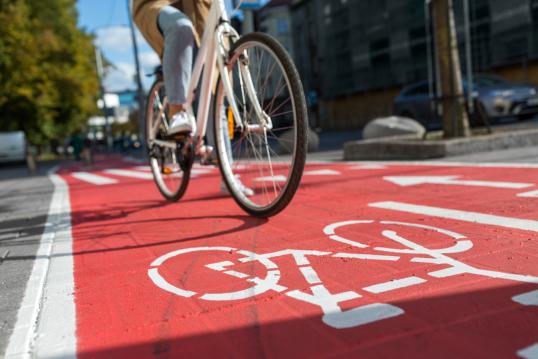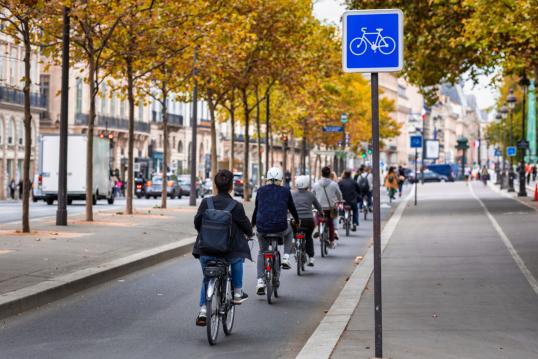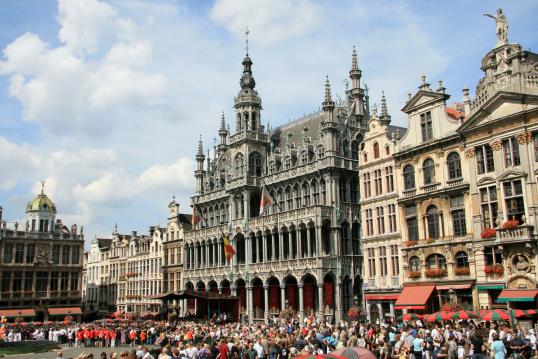- Topic
- Walking and cycling
- Country
- Europe-wide
- Resource type
- Case study
First published 18 Oct 2023
The case study explores the pro-cycling initiatives of some front running and up-and-coming cycling cities in Europe: Brussels, Milan and Paris. Each city and its resident population is unique and therefore, local and national governments have made their own local-specific efforts to achieve the same goal: to increase the modal share of cycling. Cities are finding themselves at different points along the trajectory to meet this goal. We explore examples of the progress, achievements and milestones that have been met already, along with key challenges and lessons learned along the way.
Context
Historically, cities have often been designed to prioritise cars rather than more active and sustainable modes of transport, such as cycling. As a result, cycling is often considered dangerous or inaccessible by many city residents. The onset of the Covid-19 pandemic caused a considerable shift in this narrative. With news of bicycle sales tripling, retailers running out of bicycles, and repair shops booming, 2020 has been commonly earmarked as the ‘great bicycle boom’, witnessed by city dwellers worldwide. The pandemic triggered unprecedented interest in this mode of transport, with a surge of new or returning cyclists recruited across Europe and further afield. The pandemic allowed for a reprieve from vehicle traffic, as many people were encouraged onto the saddle, spurred by a new-found confidence to cycle in quieter, safer streets in urban districts that were previously dominated by fleets of cars, taxis, vans, and buses. This was backed up by significant reactionary investment in cycling across European cities; the European Cyclists’ Federation (ECF) estimated that the continent’s cities spent €1 billion on Covid-related cycling measures in 2020, creating at least 1,000km of cycle lanes, traffic-calming measures and car-free zones.
Three examples of cities that witnessed their own renaissance in cycling during 2020 are Brussels, Milan and Paris. Paris witnessed an estimated 60% increase in cycling levels in 2020 and 2021, compared to 2019; Brussels reported a massive 64% increase in cycling in 2020; and bicycles accounted for 25% of all vehicles on one of Milan’s busiest roads during the Spring of 2020.
The benefits of a shift from cars to bicycles, both for society and the environment, are substantial; this powerful zero-emission mode of transport could bring about cleaner air, less traffic, and healthier people in cities across the world. These benefits were recently highlighted in the European Commission’s European Cycling Declaration released on 4 October 2023; in this Declaration, cycling is named as one of the most sustainable, accessible, healthy, and inclusive modes of transport with great potential to help achieve EU-wide decarbonisation targets and also add significant value to the EU economy. The policymakers of Brussels, Milan and Paris are taking different actions to reap these proven individual and collective benefits that cycling has to offer and build on the momentum and growth generated as a result of the pandemic.
In action
Although cycling may have seen a rise in the years since 2020, over three years later, with lockdown conditions eased, motorised traffic has returned en masse and remains the dominant mode of transport in many cities. A technical report published this year by the Joint Research Centre (JRC) highlights these post-pandemic trends in urban mobility and predicts that traffic and congestion may soon even exceed their 2019 levels. Therefore, it’s clear that the longevity and resilience of the cycling boom is now in question. Cities in favour of cycling are considering what actions and measures can be taken to extend the trend of choosing cycling over other modes. Amid urban population growth and growing concerns over the climate emergency, residents are often calling for action and policymakers are increasingly proposing and implementing mobility solutions.
National and sub-national policies and initiatives have huge potential to shape the experience of cyclists and keep the cycling trends on the rise. Some policymakers are acknowledging the importance of timing and the huge potential of introducing effective and stakeholder-approved policies sooner rather than later. The list of cities starting to prioritise the needs of cyclists is growing.
Identifying the local barriers to cycling is often the first step in creating an effective cycling strategy. Cycling Industries Europe (CIE) carried out a research study in 2023 which investigated the barriers to cycling and conversely the potential motivators that would encourage people to cycle more. The study involved over 8,000 respondents from across the EU and the UK, with 74% from urban areas and 26% from rural areas. 70% of respondents were regular cyclists and 30% were non-cyclists. Two key observations from the study include:
- 70% of people refrain from cycling, in part, due to the feeling that roads are unsafe for cycling.
- 40% refrain from cycling, as purchasing or renting a bicycle is too costly.
Both barriers (safety and affordability) could be tackled by implementing safe cycling infrastructure and affordable bike sharing schemes. Policymakers focusing on the main barriers their residents are facing regarding cycling are experiencing more success with shifting modal share towards active travel. When aiming to tackle the above problems of safety and the lack of access to a bicycle, initiatives will often take the form of expanding cycling infrastructure and integrating affordable bike sharing schemes into mobility plans.
With its 2.2 million inhabitants, Paris is one of the three most polluted European capitals. Mayor Anne Hidalgo’s vision of a completely cyclable capital city aims to tackle this problem. The ambitious Plan Vélo is the blueprint to bring this vision to life, as it promises a network of new protected cycleways and plenty of cycle parking spaces. A new phase of the Plan Vélo was introduced last year which promises to capitalise on the pandemic’s cycling boom, reduce motorised traffic, and encourage active travel with the backing of €250 million of investment. Of the French non-cyclists surveyed in CIE’s 2023 study, 79% indicated that a key barrier preventing them from cycling is the lack of road safety for cyclists and 40% indicated that a stimulus that would encourage them to cycle is “knowing that I can cycle in a protected lane away from other forms of transport”. Plan Vélo proposes interventions that aim to tackle this significant barrier, including the key objective to complete the proposed cycling network by 2026.
The updates to Plan Vélo in 2021 saw the introduction of some additional innovative ideas, in addition to the development of an extensive network of cycle routes. One, in particular, is the roll out of a national, universal cycling programme. The programme was initially launched in 2019 but received a boost of investment in the second phase of Plan Vélo. Known as “Savoir rouler à vélo” (SRAV), the initiative aims to teach 800,000 schoolchildren per year in cycling readiness and safety by 2027.
Plan Vélo also outlined intentions to roll out bike maintenance training, establish repair workshops in each district of the city, and encourage cycling tourism. Policymakers also engaged with the public and discovered that bicycle theft was a significant reason why people give up cycling. Therefore, an important proposal of Plan Vélo aimed to tackle this issue by installing 20 million secure cycle parking spaces across the city. There will also be financial support available to help companies build and sell more than 1.4 million bikes annually over the next four years, in order to promote more bike production within the country.
Meanwhile, the wider transport plan saw speed limits on the streets of central Paris capped at 30km/h from August 2021, which aimed to increase road safety but also have positive knock-on effects on cycling modal share.
After the launch of the updated Plan Vélo, the French government supported a coalition of stakeholders in producing a White Paper on the integrated development of the French cycling economy. Key findings and recommendations developed in the White Paper were presented at an event in Paris on 15 November 2022. The document made a strong argument linking cycling to a range of socio-economic benefits and business opportunities. Nine key proposals were outlined in the White Paper; which could provide a blueprint for other European nations aiming to implement their own pro-cycling strategies:
- Create a governance structure to oversee all relevant actors and to lead common projects.
- Create a data observatory to measure the impact of actions and to guide policies and projects.
- Restore and upscale innovative, sustainable and competitive bicycle manufacturing in France with the goal of increasing domestic production to two million bicycles per year by 2030.
- Promote innovation in the sector to meet user needs and to be more competitive.
- Anticipate the need for skills and training, developing employment and strengthening the attractiveness of cycling-related professions.
- Promote and strengthen sustainable, socially-responsible and locally-embedded production and use of bicycles, notably by offering the possibility for every person to have their bicycle repaired less than 15 minutes away from their home by 2030.
- Make France the first destination for cycle tourism worldwide by 2030.
- Stimulate the accelerated implementation of a comprehensive cycling ecosystem with a high level of service that is suitable for all, notably by increasing the availability of safe infrastructure and combatting bicycle theft.
- Promote the actors of the cycling economy and its environmental, social and economic benefits in France and in Europe.
Brussels has its own multi-faceted plan to tackle car dependence and encourage the uptake of cycling. The regional mobility plan for Brussels, Good Move, came into effect on 16 August 2022 and with it came one-way streets and limited-access zones to restrict car use through the city centre. The fundamental goal of Good Move is “to re-establish the balance between the car mode and other modes of travel in order to improve the routes of active modes as well as the performance of surface public transport”. Good Move is the outcome of an extensive four year-long participatory process involving all stakeholders including residents, mobility and institutional partners, municipalities, and businesses. It follows the so-called ‘STOP principle’, which creates a hierarchy for modes of transport; the hierarchy prioritises bicycles as well as pedestrians, public transport and finally cars for those who need them. Good Move is the overall traffic and mobility plan of the Brussels Capital Region. However, Brussels’ municipalities have the power and agency to implement it, according to specific local needs and wishes.
As part of the plan to make Brussels a peaceful, safe, diverse, and pleasant place to live for all generations, a 30 km/h speed limit was established in the streets of the capital. Brussels, since 2020, has enhanced both its temporary and permanent cycling infrastructure and rolled out a range of initiatives to encourage cycling, including additional repair centres and car free neighbourhoods.
The Bikes in Brussels Fund, managed by the King Baudouin Foundation, is playing a significant role in paving the way for cycling in the community. The project is funding 15 new cycling development and parking projects in 19 communes of Brussels. Stakeholders are active decision-makers in allocating the funding, as the individual projects are led by schools, local authorities, sports clubs and associations.
Milan is often cited as one of the most car-dependent and polluted cities in Europe and, according to their own research, half of the city’s large particulate matter (PM10) and nitrous oxide pollution comes from road transport. Milan residents are calling for action to tackle this issue. A survey carried out in 2020 showed that four out of five residents in Milan are demanding protection against air pollution, even if the protection requires giving more public space to walking, cycling and public transport. Milan has been an underdog in pro-cycling initiatives, especially in comparison with its neighbours in France. However, it is quickly becoming a trailblazer as the city aims to improve air quality for both their local population and the millions of tourists that the city welcomes every year.
In April 2020, during the early stages of the pandemic, Milan reacted to the needs of its residents by introducing 22 miles of new, protected, temporary cycle lanes as part of their Strade Aperte plan, which translates as “Open Roads”. The cycle route created on Corso Buenos Aires quickly became popular, and in 2021, it was estimated that it was used by as many as 10,000 cyclists a day, an increase of 122% in just a few months. Meanwhile, Covid lockdown measures were resulting in significant decreases in traffic by up to 75%.
The city has since set an ambitious target to increase cycling levels to a modal share of 20% by 2035. To do so, Milan has invested €225 million into its stakeholder endorsed Cambio cycling mobility plan which promises the addition of 750 km of main cycling paths to connect the city with all 133 of the communes within its wider metropolitan area. The investment will also fund the installation of fibre optic cables for smart solutions, such as low-impact lighting which will turn on at night as cyclists pass by and recharge during the day. The aim is that, within 1 km of any of the proposed paths, the network should reach: 86% of the resident population; 77% of the offices; 78% of the workers; 79% of high schools; 83% of railway stations; 74% of healthcare centres; and between 69% and 85% of local businesses.
Beatrice Uguccioni, Mobility Councillor for the Metropolitan city of Milan, indicated that the main goal is to make the bicycle the most convenient mode of transport for everyone. “Imagine being able to move around the whole metropolitan area on a bicycle,” stated Uguccioni, “to reach cinemas, schools, health centres and meeting places on innovative routes and to do so in complete safety”.
Results
Pro-cycling policies, initiatives and advocacy have made cycling a more popular, resilient and reliable option to get from A to B in these cities. If not yet reaching their ultimate targets, these policies have at least put the cities on a trajectory toward becoming more accessible, healthy and safe places to live.
In Paris, the initial Plan Vélo 2015-2020 helped to increase cycle trips by 50% in the course of 2019 and 2020. Overall, the number of cyclists using designated cycle routes is reported to have increased by 60% from pre-pandemic levels. A number of socio-economic benefits have been generated as a result of the Parisian efforts to increase cycling including:
-
The city’s bike-sharing scheme, Vélib, has created many new jobs for local people; Smovengo, the operator partner of Vélib, employs almost 500 people for the maintenance and regulation of the public service.
- The goal to make cycling accessible to all, from an early age is also well underway as 200,000 children have already been trained in France through the “Know how to ride a bike” programme. Approximately 20% of the students trained through the programme so far come from “priority neighbourhood districts”. According to data from INSEE, France’s national statistics body, these districts normally have a higher proportion of unemployment, single-parent households, and social housing. Therefore, the programme operating in Paris and across the country is working as an effective measure of bridging disparities and tackling inequality.
- Development of an economic sector dedicated to cycling, from assembly to recycling, which promises investment, innovation and employment.
Paris’ bike sharing scheme, Vélib, with currently almost 1,500 docking stations and an impressive fleet of 19,000 bicycles, is already succeeding at changing the vehicle composition on Parisian streets. According to the Vélib website, each bicycle is used more than 10 times per day, on average, during the summer months. Further evidence of the impact of the Paris bike sharing scheme can be found in the “Shared Ambition” benchmarking study(link is external) recently carried out by CIE. The study, published in September 2023, ranks bike sharing services in 148 European cities, creating a comprehensive and powerful tool that supports the EU’s aims for active and shared transport. It provides valuable guidance for cities to learn from best practice, maximise the potential of their bike sharing schemes and raise ambitions around measuring and setting targets for mobility. The report shows Paris leading the way with 40 bike sharing trips per 1000 head of population per day. This is the top performing city in the study, demonstrating the payoff from the city’s investment in their scheme.
It’s clear from its early progress that cycling culture in Paris is growing and Mayor Anne Hidalgo’s vision of creating a 100% cyclable city is already transforming the French capital.
In Brussels, initiatives such as the 30 km/h speed limit and the introduction of low traffic areas have already positively affected the transport modal share, shifting some travellers from the private car to active travel. One year after the implementation of the 30 km/h speed limit across the city of Brussels, positive reports have shown a 50% decrease in road fatalities compared to 2020, mirrored by an increase in the number of cycling journeys taking place.
Investment in cycling is already starting to change the landscape, improve accessibility and ease of cycling in the city. The Bikes in Brussels programme, through its investment of €635,000, is supporting 15 projects across different communities in the city. Examples of the funded projects include the installation of cycling shelters and parking in nurseries, schools, and community spaces; and the installation of cycle paths and ramps (adjacent to steps).
The initiatives across Brussels have ensured the continuous growth in cycling following 2020’s cycling boom. Evidence of their progress can also be found in the mobility study, carried out in 2023 by Transport & Environment: The state of shared & zero-emission mobility in European cities. This study highlights the Brussels mobility model as frontrunner when it comes to shared and electric transport. Brussels scored 100% in the category related to shared e-bikes and scooters. This score reflects the significant number of bikes, e-bikes and e-scooters available per 1,000 inhabitants.
Further demonstrating their progress, Brussels Mobility stated that cycling in early 2022 was significantly more popular than in the same months of 2021; the growth in January and February 2022 was 25% and 32%, respectively.
Milan’s ambitious cycling infrastructure plan proves the city’s commitment to urban mobility transformation. Progress towards their cycling modal share target can already be seen: In CIE’s “Shared Ambition” benchmarking study, Milan ranks in the top ten performing cities in the number of daily trips their bike sharing scheme provides, achieving between 12 and 18 trips per 1000 inhabitants per day.
Cycling tourism in Milan is also beginning to grow as a result of the pro-cycling initiatives. In 2022, Italy’s first cycle tourism expo was held in Milan and had huge success with 15,000 visitors attending across the two-day event. The main goal was to promote and share information about cycling holidays and leisure cycling. This strategy aligns with a key objective outlined in the European Cycling Declaration whereby cycling becomes an important enabler of sustainable tourism in the EU.
The examples across Brussels, Milan and Paris highlight the potential influence of taking a strategic approach to the development of a high-quality, connected network of bikeways to effectively increase cycling modal share. The cities are also examples of how an efficient and affordable bike share scheme can also play a key role in influencing modal share.
Challenges, opportunities and transferability
A cornerstone of Brussels’ Good Move plan, Milan’s Cambio cycling mobility plan, and the Parisian Plan Vélo, is stakeholder consultation. The involvement of stakeholders from Brussels, Milan and Paris, including residents, businesses, and advocacy groups, ensures that the policies adopted are not only well-informed and tailored to local needs, but also garner the necessary support for their implementation. These cities are examples of fostering a sense of ownership and participation among stakeholders to create pro-cycling initiatives that are more sustainable and resilient.
To encourage an uplift in cycling, and a modal shift away from car transport, cyclists in these cities were provided with a package deal including efficient cycling infrastructure, traffic calming measures and restrictions on motorised through-traffic in city centres or residential neighbourhoods. However, each city has its own specific approach. Cerema, a French public agency responsible for developing and capitalising on public expertise in the field of planning, regional cohesion and ecological and energy transition, developed recommendations for successful city initiatives to encourage cycling adoption. They highlighted that every city and urban space will require tailored solutions to promote cycling uptake. However, all measures will follow the same underlying premise: restricting car use while finding innovative, local-specific ways to facilitate safe cycling.
The recent adoption of the European Cycling Declaration represents a pivotal moment for cycling in the EU, outlining a vision of the future of cycling. Member States, together with regional and local authorities, will play a key role in reimagining and transforming their local urban mobility and public spaces in line with these commitments. Moving forward, the European Parliament and the Council will continue to endorse the Declaration and will periodically review the content, adding further commitments where necessary. For Brussels, Milan and Paris, their work implementing these principles has already begun but they each have their own journey ahead to turn the vision into reality and unleash the full potential of cycling.
In Depth
15,000 visitors in two days at Fiera del Cicloturismo. - Bikenomist
635,000 euros for 15 new cycle projects in Brussels | Koning Boudewijnstichting (kbs-frb.be)
A new cycling plan for a 100% cycling city - Ville de Paris
Boosting the cycling economy: France takes ambitious step in becoming “another cycling nation” | ECF
City Ranking - 2023 focused edition - Clean Cities Campaign
Cycling is still on the rise in Brussels | Eltis
Europe doubles down on cycling in post-Covid recovery plans | Cycling | The Guardian
France Will Spend €2 Billion To Double Bike Lanes, Expand Cycling (forbes.com)
France’s Plan For Universal Cycle Training Is A Win For Equity. Here’s How It Works. (nextcity.org)
Good Network | Brussels Mobilty (mobilite-mobiliteit.brussels)
Milan Plans Bike Lane Infrastructure to Rival Paris - Bloomberg
Milan to build Cambio network of cycle highways linking 80 per cent of city (dezeen.com)
Post-pandemic trends in urban mobility: JRC Publications Repository
Presentazione_CAMBIO_Consiglio_29nov2021 (cittametropolitana.mi.it)
The 2023-2027 Bike and Walk Plan is launched | gouvernement.fr
Photo credits:
- © Lorenzo Photo Projects, archimede, Latent Image, LENS-68, Patryk Kosmider, Ground Picture - no permission to re-use image(s) without separate licence from Shutterstock
- Milan embarks on 750km cycle path network - Infrastructure - MOVEMNT







